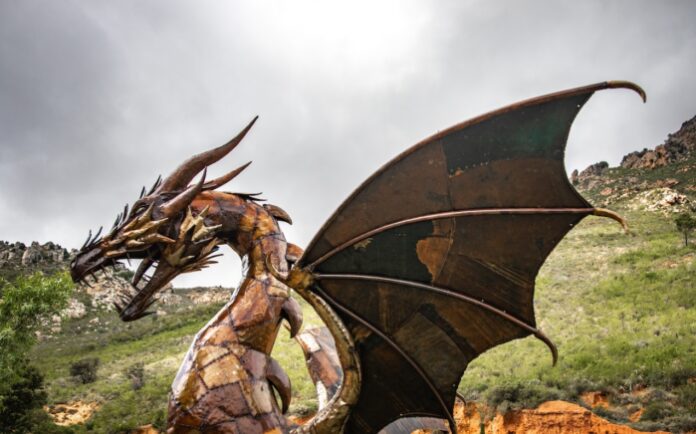Dragons are ancient mythical creatures known for their large size, jagged body structures, and scaly skin, and they are most famous for their fire-breathing abilities, depending on who’s telling the story. Dragons have been present in art and culture from Ancient China to Europe in the form of dragon paintings, sculptures, weaving, and entertainment.
What do they signify, and how do they impact 21ist century art and culture? This article will explore these questions and provide examples of historical dragon paintings you should know.
Brief Overview of Dragons in Art and Culture
The word Dragon is the Greek word “drakon,” which means water snake or gigantic reptile. Across world cultures, dragons represent various notions and serve different uses in dragon paintings and art.
Although it is not clear how dragons came to be, different cultures have interpretations and lore featuring the creatures. When it comes to art, dragons were first mentioned as far back as the ancient Greeks and Sumerians.
What differentiates the cultures is how the dragons are represented. You’ll notice the difference in representation, particularly in European and Chinese cultures. The dragons in historical dragon paintings and art from both cultures are perceived differently and have different physical features.
- The Chinese dragons we see on new years celebrations are big-eyed, snake-like, with short legs, long torsos, and fire breathing. For the people of that region, dragons were kind and benevolent, as was symbolic of their emperor.
- In India, dragons symbolized drought and were evil.
- Persians saw the dragon as a symbol of war and used dragon imagery on their emblems to instill fear.
- European dragons have lizard-like bodies covered in solid and protective scales, strong limbs, bat-like wings, menacing eyes, and fiery breath. They associated dragons with evil, a threat to human civilization that must be conquered, neutralized, or dominated by a brave knight or ruler.
Dragons in Christianity and Christian Religious Culture
As mentioned earlier, dragons were seen as mythical creatures known to protect or destroy. When the Christianity began spreading, so did the notion that dragons were dangerous, sinister creatures.
The most popular and perhaps significant references to dragons in Christian history are the following:
- Book of Job, chapter 41
- Revelations chapters 12 and 20
- Isaiah, chapter 27
These verses describe a great, big, fire-breathing monster that lives deep into the sea called Leviathan. In some verses, Leviathan is used as referring to the fallen angel.
Book of Job, Chapter 41, verses 19 to 21 reads:
- “Its back has rows of shields tightly sealed together; each is so close to the next that no air can pass between. They are joined fast to one another; they cling together and cannot be parted. Its snorting throws out flashes of light; its eyes are like the rays of dawn.”
- “Flames stream from its mouth; sparks of fire shoot out. Smoke pours from its nostrils as from a boiling pot over burning reeds. Its breath sets coals ablaze, and flames dart from its mouth.”
The verses from Revelations and Isaiah refer to the fallen angel and Leviathan as a dragon.
- Revelation 12 verse 3: “Then another sign appeared in heaven: and behold, a great red dragon having seven heads and ten horns, and on his heads were seven diadems.”
- Isaiah 27 verse 1: “In that day the Lord will punish Leviathan the fleeing serpent, with His fierce and great and mighty sword, even Leviathan the twisted serpent; And He will kill the dragon who lives in the sea.”
Some Christian religious paintings also feature dragons as a creature to be defeated and trampled. An example is Saint George and the Dragon painting adapted by various artists.
Historical Dragon Paintings: European vs. Chinese Style
Nine Dragons by Chen Rong (1244) – Chinese
Nine Dragons is a scroll painting by Chinese artist Chen Rong painted in 1244. It measures 46.3 cm × 1496.4 cm and is read and observed from right to left. Nine Dragons painting features nine dragons apparitions lying and soaring through the clouds, rocky mountains, fire, and mists.
The number nine is auspicious in Chinese culture, and the nine dragons are said to symbolize the nine sons of the Chinese Dragon King, also known as the Dragon God, over water and weather. In Chinese culture, he is regarded as the god who dispenses rain.
Saint George and the Dragon by Raphael (1505) – European
Saint George and The Dragon is a small oil on wood painting by Italian High Renaissance painter Raphael. It depicts the European lore of Saint George rescuing a village from the oppression of a dragon. The dragon was said to have terrorized the villagers by demanding human sacrifices.
Raphael wasn’t the only one to paint a depiction of this story. Peter Paul Rubens also created a Baroque-style painting of the same subjects called Saint George and the Dragon between 1605–1607.
Dragons in Modern Entertainment Art Culture – Game of Thrones, Harry Potter, House of the Dragon
People living outside of China had all but forgotten about dragons and their impact until fantasy TV series and literature became popular. Some of these television series featuring dragons were adapted from literature such as the Harry Potter novels by J.K. Rowling, The Lord of the Rings by J.R.R. Tolkien, and Game of Thrones Books by George R.R Martin.
Before then, many parts of the world, excluding China, had forgotten that dragons were prominent. But now, you’ll find paintings of dragons littered across the internet in tribute to the ubiquitous fire-breathing creatures from the Game of Thrones franchise.
Conclusion
Dragons have been a part of art and culture from ancient Chinese and European civilizations to modern influences in culture, entertainment, art, and literature. However, to create masterful dragon art, you must first understand what they signify to different cultures.
Find a Home-Based Business to Start-Up >>> Hundreds of Business Listings.

















































